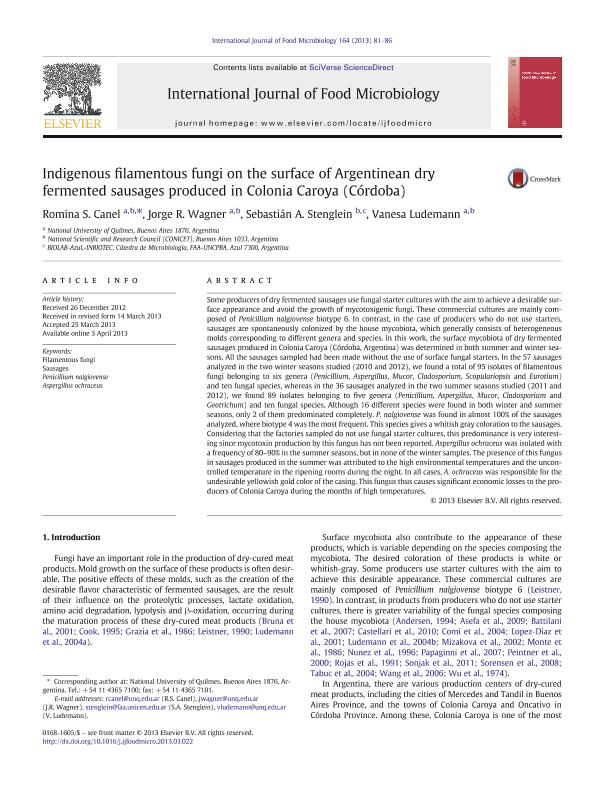Artículo
Indigenous filamentous fungi on the surface of Argentinean dry fermented sausages produced in Colonia Caroya (Córdoba)
Fecha de publicación:
06/2013
Editorial:
Elsevier Science
Revista:
International Journal of Food Microbiology
ISSN:
0168-1605
Idioma:
Inglés
Tipo de recurso:
Artículo publicado
Clasificación temática:
Resumen
Some producers of dry fermented sausages use fungal starter cultures with the aim to achieve a desirable surface appearance and avoid the growth of mycotoxigenic fungi. These commercial cultures are mainly composed of Penicillium nalgiovense biotype 6. In contrast, in the case of producers who do not use starters, sausages are spontaneously colonized by the house mycobiota, which generally consists of heterogeneous molds corresponding to different genera and species. In this work, the surface mycobiota of dry fermented sausages produced in Colonia Caroya (Córdoba, Argentina) was determined in both summer and winter seasons. All the sausages sampled had been made without the use of surface fungal starters. In the 57 sausages analyzed in the two winter seasons studied (2010 and 2012), we found a total of 95 isolates of filamentous fungi belonging to six genera (Penicillium, Aspergillus, Mucor, Cladosporium, Scopulariopsis and Eurotium) and ten fungal species, whereas in the 36 sausages analyzed in the two summer seasons studied (2011 and 2012), we found 89 isolates belonging to five genera (Penicillium, Aspergillus, Mucor, Cladosporium and Geotrichum) and ten fungal species. Although 16 different species were found in both winter and summer seasons, only 2 of them predominated completely. P. nalgiovense was found in almost 100% of the sausages analyzed, where biotype 4 was the most frequent. This species gives a whitish gray coloration to the sausages. Considering that the factories sampled do not use fungal starter cultures, this predominance is very interesting since mycotoxin production by this fungus has not been reported. Aspergillus ochraceus was isolated with a frequency of 80–90% in the summer seasons, but in none of the winter samples. The presence of this fungus in sausages produced in the summer was attributed to the high environmental temperatures and the uncontrolled temperature in the ripening rooms during the night. In all cases, A. ochraceus was responsible for the undesirable yellowish gold color of the casing. This fungus thus causes significant economic losses to the producers of Colonia Caroya during the months of high temperatures.
Palabras clave:
FUNGI
,
SAUSAGES
,
PENICILLIUM
,
ASPERGILLUS
Archivos asociados
Licencia
Identificadores
Colecciones
Articulos(CCT - MAR DEL PLATA)
Articulos de CTRO.CIENTIFICO TECNOL.CONICET - MAR DEL PLATA
Articulos de CTRO.CIENTIFICO TECNOL.CONICET - MAR DEL PLATA
Articulos(INBIOTEC)
Articulos de INSTITUTO DE INV. EN BIODIVERSIDAD Y BIOTECNOLOGIA
Articulos de INSTITUTO DE INV. EN BIODIVERSIDAD Y BIOTECNOLOGIA
Articulos(SEDE CENTRAL)
Articulos de SEDE CENTRAL
Articulos de SEDE CENTRAL
Citación
Canel, Romina Soledad; Wagner, Jorge Ricardo; Stenglein, Sebastian Alberto; Ludemann, Vanesa; Indigenous filamentous fungi on the surface of Argentinean dry fermented sausages produced in Colonia Caroya (Córdoba); Elsevier Science; International Journal of Food Microbiology; 164; 1; 6-2013; 81-86
Compartir
Altmétricas




